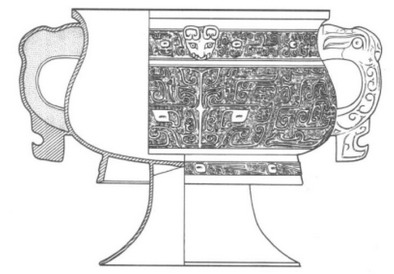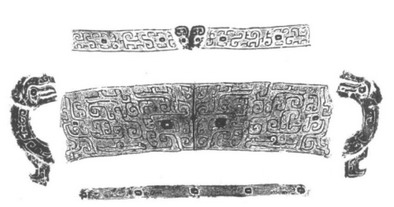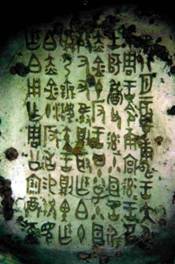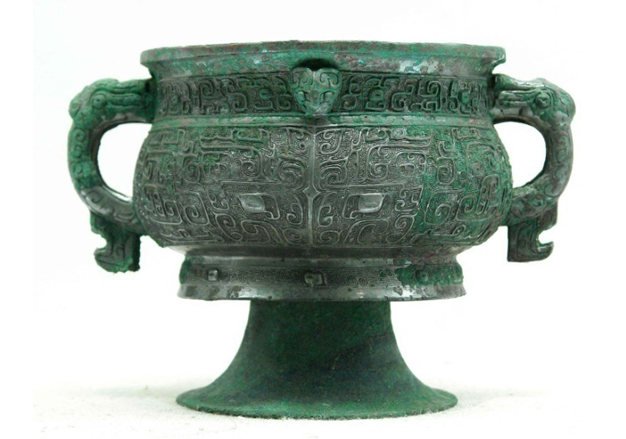Archery was useful for hunting wild animals and defense against enemies. According to inscriptions on oracle bones and bronze artifacts, the archery ritual came into existence during the late Shang Dynasty. The ceremony reached its peak of popularity during the Western Zhou Dynasty, when archery became a ritual skill required of all the nobles. Images of nobles attending archery rituals can still be seen on Eastern Zhou bronze pots with inlaid decorations. In contrast, such images have been rarely found on artifacts of the Warring States Period, which indicates that the tradition was gradually disappearing at the time along with the crumbling of the 'ritual and musical' system.
It can be known from bronze inscriptions that the archery ritual was not held on any definite day of the year; instead, it was mostly held during the King of Zhou's travels across his country or on occasions for other purposes. It is recorded that the Grand Archery Ritual and the Country Archery Ritual were usually held in spring and autumn each year. The Grand Archery Ritual described in the inscription on Zuo Bo gui was held in the eighth lunar month, when it was autumn.
The inscription here says that the ceremony was presided over by the king of Zhou, who did not personally participate in the game. However, inscriptions on other bronze vessels such as the lid of Yi He Container (A Compendium of Bronze Inscriptions of Yin and Zhou: 9453) say that the king also took part in the game. Therefore, it might be true that the king sometimes only presided over the game and sometimes also joined it [3].
The gui was a kind of food container used during the Shang and Zhou Dynasties. A large number of bronze gui of the Shang/Zhou Dynasty have been unearthed. Beginning from the mid Western Zhou Dynasty, gui was used together with a certain number of ding (cauldrons) as an important symbol of a tomb occupant's social status. The fact that ding and gui have been unearthed from almost all large and medium-sized tombs offers compelling evidence that these two played a central and highly prestigious role among bronze ritual vessels in the Zhou Dynasty.
Gui vessels unearthed by archaeologists can be divided into two categories: those with ring bases and those with square bases. The former has a flared ring base joined to the belly, while the latter has a square base attached to the ring base. Some gui of the former type have three or four hoof-shaped feet under the ring base. On a very small number of gui, such as Ban gui collected in the Capital Museum, the pendant-like ornaments beneath the four ears around the belly are so long that they droop and curve inward into four feet.
A careful observation of Zuo Bo gui can reveal that the two ears and the main body were cast separately before they were joined to each other and that the trumpet-shaped prop is made of a different kind of bronze than vessel itself. How was the prop joined to the vessel during the Western Zhou Dynasty in the absence of modern welding techniques?
Your answer please, if you have any questions or answer, please feel free to send us email, we are waiting for your answers and participation, and your comments, answers and suggestions will be highly appreciated. We will select and publicize the most appropriate answers and comments some time in the future.
Weekly Selection Email: meizhouyipin@chnmus.net
The Terms for Participants in the Archery Ritual Described in the Inscription on Zuo Bo Gui
Who were the participants in the archery ritual recorded in the inscription on Zuo Bo gui? First of all, there was Nangong, who was in charge of the team made up of the king's sons and brothers. In the excavators’ opinion, Nangong was an official position. Next was Mian Fu (Shi official), who headed the team made up of the king's officials. Mian Fu was his name and Shi was his official position. He was probably a military officer, for Shi usually denotes a military officer in bronze inscriptions. Then there were 'wang duo shi' (the king's officers), who were also addressed as xiao zi (literally 'my little ones') in bronze inscriptions. There is much controversy among scholars as to who these officers were and why they were also called 'my little ones'. A more reasonable explanation is that 'the king's officers' referred to the young men in the king's clan who had noble ranks; however high their ranks might be, they were 'little ones' before the king. In the inscription on Zuo Bo gui, the participants in the game, including the young men in the king's family and the Earl of Zuo himself, are referred to as 'the king's officers' in the account of the event, whereas the king addressed those young men as 'my little ones' when giving his command. Finally there were xiao chen, which was interpreted by the excavators as 'young slaves'. However, slaves would have been too lowly to participate in such an important ceremony. Therefore, xiao chen probably refers to the king's officials.
Notes
[1] Henan Provincial Institute of Cultural Relics and Archaeology, the Cultural Heritage Management Bureau of Pingdingshan City. The Ying-state Cemetery in Pingdingshan (1). Elephant Press, 2012, pp. 144-172.
[2] Wang Longzheng, Jiang Tao & Yuan Junjie. 'The Newly Discovered Zuo Bo Gui and an Interpretation of Its Inscription', in Cultural Relics, 1998 (9).
[3] Yuan Junjie. 'More Reflections on Zuo Bo Gui and the Grand Archery Ritual', in Huaxia Archaeology, 2011 (2).
[4] Zhu Fenghan. 'An Analysis of Zuoceban Yuan', in Chinese History and Cultural Relics, 2005 (2).
[5] Cao Wei. 'The Practice of Funeral Donations during the Eastern Zhou Dynasty', in Archaeology and Cultural Relics, 2002 (6).
The vessel has a round flared mouth, a sharp-edged slanting rim, a contracted short neck, and a shallow belly that bulges and droops slightly. The belly is adorned with a pair of dragon-shaped ears with pendant-like ornaments beneath them. The ring base extends outward slightly and is linked to a trumpet-shaped prop. The neck is adorned with two groups of kui-dragon pattern, each centering around an animal head in relief. On the belly are two groups of animal masks with protruding eyes. The upper parts of the ears are decorated with dragon heads and the lower parts with coiled cloud designs on both sides. The whole ears curve inward and downward. The ring base is embellished with a raised cloud design whereas the trumpet-shaped prop is plain (Fig. 1 & 2). The clear difference between the color of the rust on the body and that on the prop is due to the significant difference in the quality of bronze.


The interior bottom of Zuo Bo gui bears an inscription of 74 characters in eight lines (Fig. 3):


隹(惟)八月辰(晨)才(在)庚申,王大射
才(在)周。王令(命)南宫 (率)王多
士,师 父 (率)小臣。王徲(遟)
赤金十反(钣)。王曰:“小子、小臣,
敬又(有) (贤),隻(获)则取。”柞白(伯)十
爯(称)弓無(无)灋(废)矢,王则畀柞
白(伯)赤金十反(钣),诞易(赐) 见。
柞白(伯)用乍(作)周公宝尊彝。
The general meaning of the inscription is as follows:
On the day of Gengshen in the eighth lunar month, the King of Zhou held a Grand Archery Ritual in the capital Haojing. The participants were divided into two teams, with Mian Fu (Shi officer) leading the king's officials and Nangong (official) heading the king's sons and brothers with noble ranks. The king offered ten copper plates as the prize. He said, 'My xiao zi and xiao chen, conduct yourself with prudence and modesty during the game. He who hits the target the most times can get these ten copper plates.' The Earl of Zuo (Zuo Bo) shot ten arrows and hit the target each time. So the king awarded him the prize plus two musical instruments. To commemorate the special honor, the earl had this bronze gui made out of the copper to be used for offering sacrifices to the Duke of Zhou[2].

